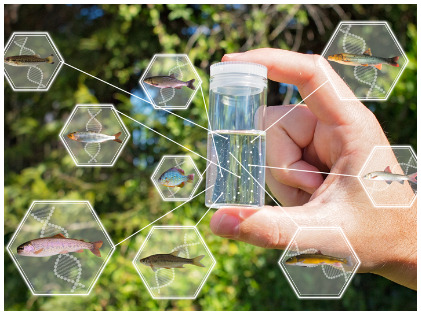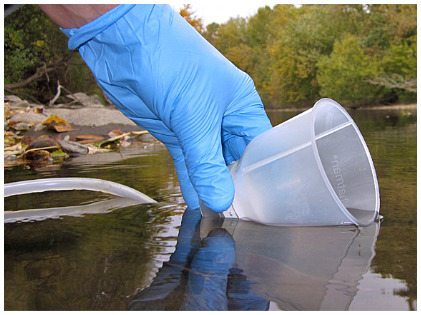
Environmental DNA Is Changing the Way Ecologists Do Their Job – And It’s Fantastic!

Like many good stories, this one starts with a bunch of cr*p – literally. It was when Kristine Bohmann of the University of Copenhagen collected a bag of bat droppings that an idea struck her – to inspect the droppings not microscopically, but genetically. You see, Bohmann was on a mission in 2010 in the Eswatini area, searching for evidence that the bats in the area were feeding off of crop pests and that crop farmers were having an effect on the habitat of these bats. To prove this, she was to inspect the droppings to identify the insects the bats were consuming. While this is generally done under a microscope, Bohmann decided to use genetic sequencing instead – fancy, eh?
DNA Sequencing
 Ecologists are becoming more and more reliant on DNA sequencing in order to conduct their research. This DNA is the DNA that is shed by organisms into the surrounding environment, and it is termed environmental DNA or eDNA. This incredible leap in technology puts an end to having to trek into the fields for months at a time to collect and taxonomically organize and identify organisms. By tapping into sources like fish scales, blood, feces, saliva, urine, and skin cells, scientists can measure rather accurately the biodiversity of an area and identify various invasive, endangered, and rare species.
Ecologists are becoming more and more reliant on DNA sequencing in order to conduct their research. This DNA is the DNA that is shed by organisms into the surrounding environment, and it is termed environmental DNA or eDNA. This incredible leap in technology puts an end to having to trek into the fields for months at a time to collect and taxonomically organize and identify organisms. By tapping into sources like fish scales, blood, feces, saliva, urine, and skin cells, scientists can measure rather accurately the biodiversity of an area and identify various invasive, endangered, and rare species.
Early Techniques
Early procedures for eDNA surveys made use of PCR, or polymerase chain reaction, to amplify the DNA collected. However, newer and more modern systems, as used by Bohmann, can target an entire range of species’ DNA in one single sample, instead of just an individual species. Of course, these modern techniques have opened doors for eDNA surveyors who can become more ambitious and more innovative with the scope of their work.
Modern Techniques Still Need Improving
 The technology has room for improvement, as it does require development in estimating population abundance. Further, the techniques do require sophisticated and expensive laboratory equipment of specialized nature, featuring bioinformatics skills. Needless to add, ecologists still have to get their hands and knees dirty, going out and collecting samples outdoors!
The technology has room for improvement, as it does require development in estimating population abundance. Further, the techniques do require sophisticated and expensive laboratory equipment of specialized nature, featuring bioinformatics skills. Needless to add, ecologists still have to get their hands and knees dirty, going out and collecting samples outdoors!
As technology develops, this will come to change, and the eDNA survey conducting will grow cheaper over time. As for databases, there is still a great need for taxonomic specialists in building the reference databases on which the eDNA technology depends. In the new techniques, abundance in the environment is not accurate, and population estimates cannot be put together, as can be done with the mark and recapture system of surveying. Another big challenge that researchers face is contamination mainly when dealing with trace eDNA. To avoid that it a meticulous use of boots, wetsuits, gloves, and other equipment is necessary.
The Other Benefits
The work it takes to gather information for surveys can often be time-consuming and even risky. For instance, the study conducted by ecologist Stephen Spear, who surveyed US sites for a salamander, having to peer under rocks and walk through creeks. He even snorkeled through the waters in search of the species. He has had rocks fall onto his arm and has colleagues who have suffered broken bones from the same accident. With the new eDNA technology, all Sper needs to do is collect water from points along the river or stream to test for eDNA. This eliminated many risks and drastically reduces time consumption.
Creative Sampling
 Samples from where you can detect eDNA traces are endless. It seems the study of geographical regions can be done using sources of flowers, leeches, and even the air! In one study, eDNA of over 100 species of insects and arthropods were found from wildflowers. Without eDNA technology, scientists would have to sit beside the flower and watch every insect that visited, identifying, and recording them.
Samples from where you can detect eDNA traces are endless. It seems the study of geographical regions can be done using sources of flowers, leeches, and even the air! In one study, eDNA of over 100 species of insects and arthropods were found from wildflowers. Without eDNA technology, scientists would have to sit beside the flower and watch every insect that visited, identifying, and recording them.
Some creative sources to use for sampling are blood-sucking mosquitoes, marine sponges I seawater, and even flies. These creatures would be warehouses of eDNA material!
And so it happens that technology is changing the face of ecology! This is certainly an exciting time to be alive. With so many advancements and leaps in the world of technology are helping us learn incredible amounts of information at a time. We have come a long way to go in scientific advancements, indeed. But we surely have miles to go!
More in Business & Investments
-
`
WWE SmackDown to Make a Comeback on USA Network in 2024
In a surprising twist, WWE’s Friday night staple, “SmackDown,” is bidding farewell to Fox and heading back to its old stomping...
November 24, 2023 -
`
Why Women Face Higher Out-of-Pocket Health Expenses
In healthcare, disparities persist, and a recent report from Deloitte underscores a significant financial gap between working women and men in...
November 18, 2023 -
`
Elon Musk vs Bill Gates: The Clash of Titans
In the realm of the world’s wealthiest individuals, a simmering rivalry has been captivating public attention. It’s not a clash of...
November 7, 2023 -
`
The Power Of Disconnecting
In our digitally driven age, where smartphones, tablets, and laptops have become extensions of ourselves, disconnecting might seem daunting. However, the...
October 31, 2023 -
`
JCPenney’s Bankruptcy: The End of an Era
JCPenney filed for bankruptcy in a move echoing the struggles of many retailers in the wake of the COVID-19 pandemic. This...
October 26, 2023 -
`
Reasons Why You Need a Financial Plan
Financial planning is not just for the wealthy or those nearing retirement. It’s a crucial tool for anyone seeking financial security...
October 19, 2023 -
`
How Brad Pitt Spends His Millions All Over the World
Brad Pitt, the charismatic Hollywood superstar, has left an indelible mark on the silver screen and made an impact in the...
October 10, 2023 -
`
Gen Z’s Posh Palate: The Unexpected Rise of Caviar Culture
Amid the backdrop of a digital era buzzing with viral dances, e-sports, and niche memes, there emerges a peculiar plot twist:...
October 7, 2023 -
`
Transform Your Retail Business With Social Media Mastery
If you’re a retail marketer posting your social media messages haphazardly, you might be missing out on prime opportunities to turn...
September 26, 2023















You must be logged in to post a comment Login